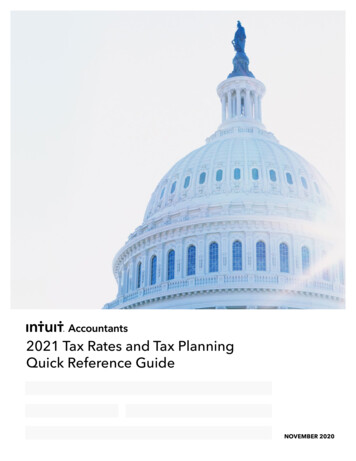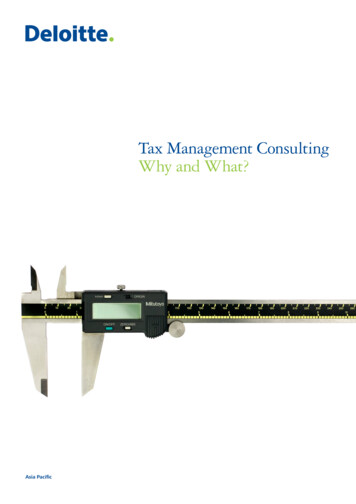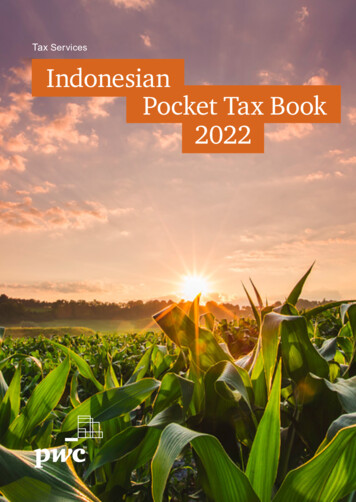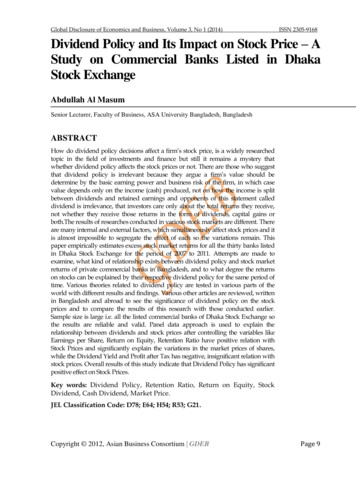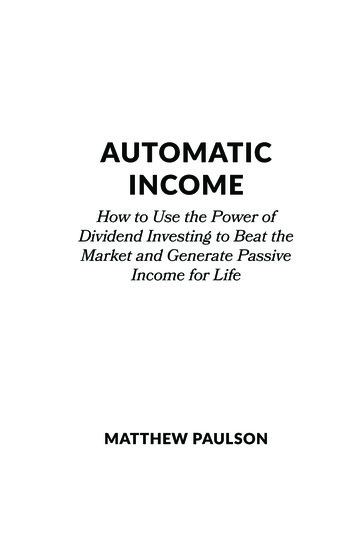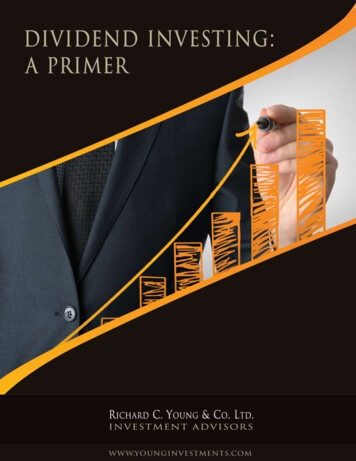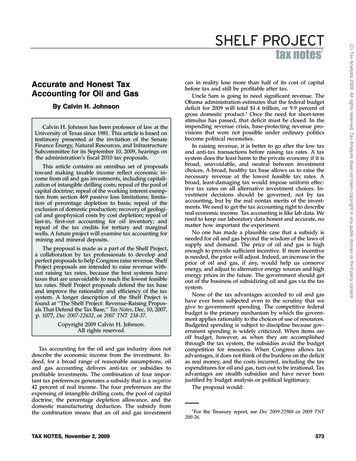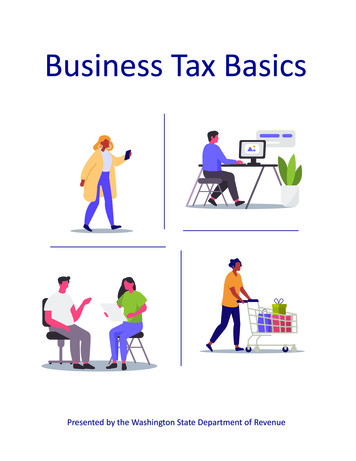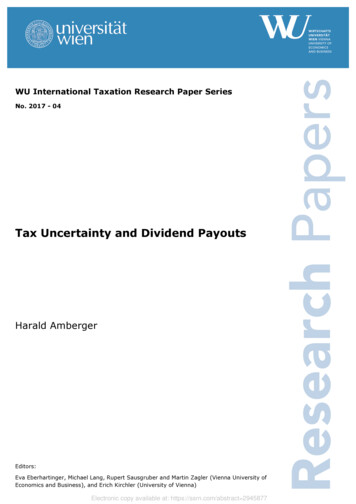
Transcription
WU International Taxation Research Paper SeriesNo. 2017 - 04Tax Uncertainty and Dividend PayoutsHarald AmbergerEditors:Eva Eberhartinger, Michael Lang, Rupert Sausgruber and Martin Zagler (Vienna University ofEconomics and Business), and Erich Kirchler (University of Vienna)Electronic copy available at: https://ssrn.com/abstract 2945877
Tax Uncertainty and Dividend PayoutsHarald Amberger*Vienna University of Economics and BusinessDepartment of Finance, Accounting and StatisticsInstitute for Accounting and AuditingTax Management GroupApril 2017I appreciate valuable comments from Kathleen Andries, Nathalie Bravo, Eva Eberhartinger, Dave Kenchington(discussant), Kevin Markle, Benjamin Osswald, Silke Ruenger, David Samuel, and Kelly Wentland, two anonymousreviewers for the ATA Midyear Meeting 2017, participants at the 3rd Doctoral Research Seminar in Vienna, theATA Midyear Meeting 2017 in Phoenix, and seminar participants in the DIBT Research Seminar at WU Vienna. Ithank the Tippie College of Business at the University of Iowa for their kind hospitality when working on this paper.I also gratefully acknowledge financial support from the Austrian Science Fund (FWF): W 1235-G16.* I can be reached at harald.amberger@wu.ac.at or 43/1/31336-5656.This is a draft version; please do not cite or circulate without the permission of the author.Electronic copy available at: https://ssrn.com/abstract 2945877
Tax Uncertainty and Dividend PayoutsAbstractI examine whether and to what extent tax uncertainty affects a firm’s dividend payouts. Based onthe argument that tax uncertainty impairs the persistence and predictability of after-tax cashflows, I hypothesize and find that firms with greater tax uncertainty exhibit a lower probability ofdividend payouts. The effect of tax uncertainty is stronger in the presence of financial constraintsand weaker for firms that distribute dividends to alleviate agency conflicts. Furthermore, I find anegative effect of tax uncertainty on dividend levels, which is moderated by the costs of dividendreductions. These results are economically meaningful as a one standard deviation higher taxuncertainty leads to a 9.9 percentage point lower probability and a 23.6 million reduction individend payouts. Taken together, my findings document a real effect of tax avoidance andcontribute to the understanding of interactions between uncertain tax avoidance and a firm’sfinancial ecosystem.Keywords:Tax Uncertainty, Tax Avoidance, Dividend Payouts, Real Effects, Share RepurchasesJEL-Classification:G30, G35, H25, H26, H32Electronic copy available at: https://ssrn.com/abstract 2945877
1.IntroductionDividend payouts to shareholders are an integral part of a firm’s financial ecosystem(Farre-Mensa, Michaely, and Schmalz 2014). In this study, I examine whether and to what extenttax uncertainty affects both the decision to distribute dividends and their amount. Goh, Lee, Lim,and Shevlin (2016) argue that shareholders benefit from tax avoidance as lower tax paymentsreduce the cost of equity. However, aside from diminishing tax payments, tax avoidance inducesuncertainty (Neuman 2016) that affects overall firm risk (Guenther, Matsunaga, and Williams2017), firm value (Drake, Lusch, and Stekelberg 2017), cash holdings (Hanlon, Maydew, andSaavedra 2017), and investment (Jacob, Wentland, and Wentland 2016). These effects of taxuncertainty, which constitutes the second dimension of a firm’s tax-avoidance strategy, castdoubt on the argument that shareholders necessarily benefit from tax avoidance.I define tax uncertainty as uncertainty in a firm’s tax position that leads to volatile taxpayments over time.1 Uncertainty in this regard stems from “grey area” tax avoidance, whichincludes tax positions with ex-ante uncertainty and a high likelihood of being overturned in a taxaudit (Dyreng, Hanlon, and Maydew 2016). Although reducing tax payments (Edwards, Schwab,and Shevlin 2016), “grey area” tax avoidance raises IRS audit risk and the chance of future taxrepayments, interest charges, and fines. As audit risk and the predictability of audit outcomesdiffer across countries, tax uncertainty is not fully idiosyncratic but conditional on countryspecific factors that are not directly under a firm’s control (e.g., the rule of law, audit effort, etc.).Recent anecdotes support the argument that tax uncertainty might adversely affect firmsand their shareholders. A Financial Times report, for instance, suggests that an increasingnumber of U.S. firms alert their investors to the negative consequences of tax uncertainty for1To provide a direct conceptual link to dividends being paid out of after-tax cash flows, I limit the definition of taxuncertainty to potential cash effects.-1-
after-tax cash flows (Houlder 2016). Based on the argument that uncertain tax payments impairsthe persistence and predictability of after-tax cash flows, I hypothesize that tax uncertaintynegatively affects dividend payouts.The hypothesized relation between tax uncertainty and dividend payouts rests on theargument that volatile tax payments contribute to overall cash-flow uncertainty. Uncertain cashflows impair the persistence and predictability of after-tax cash flows and increase the likelihoodof liquidity shortfalls. As financing liquidity shortfalls in external capital markets is costly for afirm (Myers and Majluf 1984), managers consider cash-flow uncertainty when deciding ondividend payouts (Lintner 1956, Brav, Graham, Harvey, and Michaely 2005). Further, firms withuncertain cash flows exhibit a lower probability of achieving persistent dividend levels over time(Chay and Suh 2009). Managers adjust dividend payouts to accommodate cash-flow uncertaintyas capital markets heavily punish dividend reductions and impersistent dividend levels (Healyand Palepu 1988, Michaely, Thaler, and Womack 1995). Thus, firms with greater tax uncertaintyare less likely to distribute dividends and they exhibit lower dividend levels.Several arguments, however, suggest that the effect of tax uncertainty on dividendpayouts is ex-ante unclear and therefore an empirical question. First, instead of adjustingdividend payouts, firms might delay investment to accommodate cash-flow uncertainty (Jacob etal. 2016). Second, volatility in tax payments might result from benign tax avoidance where thesources of variation in tax payments are known to managers (Guenther et al. 2017). Third,operating uncertainty might be the main driver of cash-flow uncertainty, which impedesevidence for an effect of tax uncertainty.To examine the decision to distribute dividends and the amount of dividend payouts, Iobtain two samples of U.S. public firms with financial statement data for fiscal years 1993-2014.-2-
I calculate the coefficient of variation of annual cash effective tax rates (ETRs) over five prioryears as a proxy for tax uncertainty (McGuire, Neuman, and Omer 2013, Jacob et al. 2016). Thisis an intuitive measure as firms with uncertain tax positions exhibit more volatile tax paymentsover time (Neuman 2016). In this regard, past cash ETRs are less strongly affected by financialreporting incentives than ex-ante proxies for tax uncertainty (e.g., unrecognized tax benefits(UTBs); Robinson, Stomberg, and Towery 2015) and provide a direct conceptual link todividends being paid out of after-tax cash flows. Furthermore, Drake et al. (2017) find thatvariation in past cash ETRs predicts volatility in tax payments, which allows managers to formexpectations about future tax uncertainty. I add long-run cash ETRs (Dyreng Hanlon, andMaydew 2008) in all tests to segregate the level and the uncertainty of tax payments as the twodimensions of a firm’s tax-avoidance strategy.The first set of tests analyzes a firm’s decision to distribute dividends. Results indicatethat firms with greater tax uncertainty exhibit a lower probability of dividend payouts. Thiseffect is economically meaningful as a one standard deviation higher tax uncertainty reduces theprobability of dividend payouts by 9.9 percentage points. The effect of tax uncertainty is similarto non-tax determinants of dividend payouts, which seems reasonable as tax payments representa major share of a firm’s after-tax cash flow where uncertainty is difficult to hedge.I conduct two cross-sectional tests to corroborate these results. First, I study financiallyconstrained firms and expect a stronger effect of tax uncertainty on dividend payouts as thesefirms exhibit higher costs of external financing (Whited 1992, Faulkender and Petersen 2006).Results are in line with this expectation and suggest that the relevance of tax uncertaintyincreases in the costs of obtaining external funds. In addition, these results support the argumentthat tax uncertainty affects dividend payouts through the channel of cash-flow uncertainty.-3-
Second, I analyze firms with high institutional ownership and predict a weaker effect of taxuncertainty as agency aspects dominate their dividend-payout decisions (Allen, Bernardo, andWelch 2000). Results are consistent with this prediction and suggest that managers considervolatile tax payments in a dividend-payout decision as the effect of tax uncertainty variesaccording to the motives for dividend payouts.The second set of tests examines dividend levels. For a subsample of dividend-payingfirms, I find that firms with greater tax uncertainty exhibit lower dividend levels. The effect oftax uncertainty is again economically meaningful and comparable to non-tax determinants. Aone standard deviation higher tax uncertainty reduces dividend payouts by 10 percent, which isequivalent to lower dividend payouts to the tune of 23.6 million for the average dividendpaying firm. Thus, tax uncertainty is a relevant determinant of observable dividend levels.In a third cross-sectional test, I examine young and growing firms at the capital-infusionstage (DeAngelo, DeAngelo, and Stulz 2006). I expect a weaker effect of tax uncertainty on theamount of dividend payouts as these firms exhibit low costs of dividend reductions (Leary andMichaely 2011). Results are consistent with this expectation and suggest that the effect of taxuncertainty on dividend levels varies with the costs of reducing dividend payouts.In addition to cross-sectional tests, I conduct a battery of sensitivity analyses to assess therobustness of my baseline results. First, I investigate alternative measures for tax uncertainty andshow that my results are unaffected by loss firms, winsorizing annual cash ETRs, more extremeforms of tax uncertainty, volatility in tax payments induced by benign tax-avoidance strategies,and endogeneity concerns. Second, I include firm-fixed effects in the regression, alleviatingconcerns that time-invariant firm characteristics might drive my results.-4-
In a series of supplementary tests, I provide corroborating evidence for the effect of taxuncertainty on dividend payouts. First, I conduct time-series tests and show that tax uncertaintycontributes to changes in dividend payouts over time. I also examine the 2003 dividend tax cutproviding an exogenous shock to a firm’s payout policy and document that firms with high taxuncertainty reacted less strongly to the tax reform. Second, I show that the effect of taxuncertainty is independent from a firm’s operating uncertainty. This suggests that tax uncertaintyis a dimension of overall firm risk having distinct effects on dividend payouts. Third, I examinethe relation between tax uncertainty and the level of tax avoidance and find that tax-avoidanceproxies do not capture underlying tax uncertainty. Finally, I study share repurchases as analternative distribution channel (Skinner 2008). The effect of tax uncertainty on sharerepurchases is negative but weaker, which is in line with the argument that firms can adjust sharerepurchases more easily than dividend payouts (Jagannathan, Stephens, and Weisbach 2000).My findings contribute to several streams of research and increase our understanding ofinteractions between uncertain tax avoidance and a firm’s financial ecosystem. First, the negativeeffect of tax uncertainty on dividend payouts constitutes a real effect of tax avoidance and thusanswers the call for research in Hanlon and Heitzman (2010). Together with the finding thatvolatility in tax payments has a negative effect on investment (Jacob et al. 2016), my resultssuggest that uncertain tax-avoidance strategies induce non-tax costs on shareholders. Asinvestors select firms based on their payout policy (Desai and Jin 2011), uncertain tax avoidancemight distort these decisions.Second, my findings add to a growing stream of research that examines determinants andconsequences of tax uncertainty. I extend research by DeSimone, Mills, and Stomberg (2016)and Guenther et al. (2017), who find that tax uncertainty does not increase in the level of tax-5-
avoidance. In this regard, my findings suggest that analyses of real effects of tax avoidance haveto segregate the level and the uncertainty of tax payments to identify the driver of an effect. Thus,the finding that shareholders benefit from tax avoidance (Goh et al. 2016) might not exclusivelyresult from lower tax payments but also from a lack of uncertainty in these payments.Third, my findings contribute to research on the determinants of dividend payouts (Chayand Suh 2009, Hoberg, Philipps, and Prabhala 2014) and suggest that tax uncertainty inducescross-sectional variation in the probability and the amount of dividend payouts. These findingsshould interest managers and shareholders as adverse effects of tax uncertainty on after-taxearnings are likely to affect dividend payouts. Further, my findings are relevant to legislators andsuggest that initiatives to reduce volatility in tax payments (e.g., the U.S. Compliance AssuranceProcess; Beck and Lisowsky 2014) might increase the distribution potential of firms.The remainder of the paper is organized as follows. Section 2 discusses prior researchand develops testable hypotheses. Section 3 presents the sample selection and the research design.Section 4 discusses the baseline results. Section 5 presents results for robustness tests andsupplementary analyses. Section 6 summarizes my main findings and concludes.2.Theoretical Background and Hypothesis Development2.1.Determinants of Dividend PayoutsDividend payouts are a strategic tool in capital market economies. In 2014, firms listedon the S&P 500 distributed more than 900 billion to their shareholders, with motives fordividend payouts differing across firms. Starting with the seminal paper by Miller andModigliani (1961) showing that dividends do not affect investment and firm value, research hasidentified several determinants of dividend payouts (see Allen and Michaely (2003) and Farre--6-
Mensa et al. (2014) for reviews).2 First, firms distribute dividends to alleviate agency conflictsbetween managers and shareholders. Excess cash holdings enable managers to privately divertfunds (Jensen and Meckling 1976) or to engage in suboptimal investment (Jensen 1986). In thisregard, dividend payouts constitute a disciplining device and managers are forced to raise fundsunder external scrutiny (Easterbrook 1984). In line with this argument, Officer (2011) finds thatfirms prone to agency conflicts exhibit higher dividend-initiation-announcement returns.Second, firms distribute dividends to convey privately-held information to the capitalmarket (Bhattacharya 1979, John and Williams 1985, Miller and Rock 1985). Due to informationasymmetries between managers and shareholders, dividend payouts reveal private informationand provide a signal for managers’ earnings expectations. Consistent with this argument, Grullon,Michaely, and Swaminathan (2002) find positive abnormal returns for dividend increases, whiledividend reductions are heavily punished by capital markets.Third, firms distribute dividends due to a lack of investment opportunities. A limitedinvestment set reduces cash requirements and raises the distribution potential (Smith and Watts1992). Based on this argument, DeAngelo et al. (2006) analyze the financial life-cycle theoryand document a higher likelihood of dividend payouts for more mature firms. Chay and Suh(2009) investigate a risk-based argument and find a negative relation between cash-flowuncertainty and dividend payouts. Firms with large investment sets and uncertain cash flowsadjust dividend payouts to avoid external financing and dividend reductions (Lintner 1956).Fourth, firms distribute dividends due to the relative investor-level tax on dividendpayouts (Poterba 2004). In this regard, several studies examine the dividend tax cut introduced2Miller and Modigliani (1961) assume complete and perfect markets that rest on the following assumptions: (i) notaxes, (ii) symmetric information among market participants, (iii) complete contracting, (iv) no transaction costs, (v)competitive product and financial markets, and (vi) rational investors and managers (Farre-Mensa et al. 2014).-7-
by the Jobs and Growth Tax Relief Reconciliation Act of 2003 and find that firms dominated byindividual investors experienced the largest increase in dividend payouts (Chetty and Saez 2005,Blouin, Ready, and Shackelford 2004). In addition, Desai and Jin (2011) study different investorclasses and document that investors tend to invest in a firm based on its payout policy. At thesame time, managers adjust dividend payouts to cater for investors’ tax preferences.2.2.Tax Uncertainty as the Second Dimension of a Firm’s Tax-Avoidance StrategyCash savings in the form of lower tax payments incentivize firms to engage in taxavoidance (Edwards et al. 2016). Aside from this benefit, “grey area” tax avoidance mightinduce uncertainty which results from tax positions characterized by ex-ante uncertainty and ahigh likelihood of being challenged in a tax audit (Dyreng et al. 2016). Common examples of“grey area” tax avoidance are the application of ambiguous tax rules or legislation, anddiscretion in setting intra-group transfer prices. Although initially reducing tax payments, “greyarea” tax avoidance raises IRS scrutiny and audit risk (Mills 1998). In case the IRS challenges atax position, the firm might become liable for tax repayments, interest charges, and fines.Several public cases indicate that the disputed amounts and the cash effects of “grey area”tax avoidance could be economically significant. In 2006, GlaxoSmithKline Inc., for instance,settled a transfer-pricing dispute with the IRS. Being the largest dispute in the history of the IRS(IRS 2006), this settlement included fiscal years 1989-2005 and led to tax repayments of 3.4billion and an abandoned claim of 1.8 billion. In a similar case, the Canadian tax authoritiesaccused Cameco Corp. of having engaged in “grey area” tax avoidance via intra-group transferpricing and claimed tax repayments of 2.1 billion (Livesey 2016).33GlaxoSmithKline Inc. engaged in income shifting through tax-deductable intra-group payments on intangibleassets and trademarks. These payments reduced tax payments in the U.S. (IRS 2006). Cameco Corp. used a similar-8-
Tax uncertainty is not driven by a firm’s tax-avoidance strategies alone but might dependon country-specific factors that are not directly under a firm’s control (e.g., tax enforcement, therule of law, audit cycle and effort, etc.). Current developments in the European Union supportthis argument, as the EU Commission has started to tackle initially certain tax positions throughstate aid regulation. These rules prohibit EU member states from granting selective economicbenefits to firms.4 Thus far, the EU Commission has qualified two tax rulings in Luxembourgand the Netherlands respectively as illegal state aid, leading to tax repayments of 20-30 million(EU Commission 2015a). In a recent decision, the EU Commission accused Apple Inc. of havingavoided 13 billion through tax rulings in Ireland (EU Commission 2016).5 By challenginginitially certain tax positions taken by a firm, these decisions increase tax uncertainty andcontribute to volatility in tax payments over time.Prior research has examined the concept of tax uncertainty and provides some evidencefor potential economic effects. Hanlon et al. (2017), for instance, examine cash holdings and findthat firms with uncertain tax positions hold more precautionary cash. Hasan, Hoi, Wu, and Zhang(2014) investigate debt contracts and show that the cost of debt increases with the level of taxavoidance. Consistent with Hanlon et al. (2017), Hasan et al. (2014) argue that tax uncertaintyincreases in the level of tax avoidance and therefore measure tax uncertainty with proxies for thelevel of tax avoidance (e.g., cash or GAAP ETRs, book-tax differences (BTDs), and UTBs).strategy and set a low intra-group transfer price for uranium sold by a Canadian subsidiary to a Swiss letter-boxcompany. This diminished the Canadian tax base and increased profits in the low-tax Canton of Zug (Livesey 2016).4To examine whether a tax benefit constitutes illegal state aid, the EU Commission has to imitate an investigationprocedure. If the EU Commission qualifies a tax benefit as state aid, tax authorities have to recover the benefit. Taxauthorities and countries, however, may appeal against the decision of the EU Commission at the European Court ofJustice (see Lang, Pistone, Schuch, and Staringer (2015, pp. 121–130) for further information).5In its 2015 financial statements, Apple discussed potential effects of this decision on its after-tax cash flows bystating that if “ the European Commission were to conclude against Ireland, it could require Ireland to recoverfrom the Company past taxes covering a period of up to 10 years reflective of the disallowed state aid, and suchamount could be material.” An investigation of McDonald’s Corp.’s tax positions in Luxembourg is still ongoingwith the EU Commission (EU Commission 2015b).-9-
Several recent studies, in contrast, suggest that tax uncertainty is unrelated to the level oftax avoidance. Benefits of tax avoidance in the form of cash savings (Mills 1998, Edwards et al.2016) or reduced leverage (Graham and Tucker 2006) do not necessarily induce greater taxuncertainty. This follows from the argument that firms could engage in tax-avoidance strategiesthat reduce tax payments without increasing tax uncertainty (e.g., benign tax avoidance throughR&D tax credits, accelerated depreciation, etc.). In this regard, Guenther et al. (2017) show thatlow cash ETRs are more persistent over time than high cash ETRs and that the level of taxavoidance is unrelated to future volatility in tax payments. Hutchens and Rego (2015) explorethe relation between tax uncertainty and overall firm risk more closely. Their findings suggestthat overall firm risk is unrelated to the level of tax avoidance but increases with tax uncertainty.Drake et al. (2017) examine value implications and find that tax uncertainty mitigates thepositive valuation of tax avoidance. With regard to firm-level investment, Jacob et al. (2016)document that tax uncertainty delays large capital investment and reduces capital expenditures.2.3.Hypothesis DevelopmentThe discussion in the previous section suggests that tax uncertainty affects firms and theiroperations. Firms with greater tax uncertainty have a higher probability of unexpected taxpayments; this leads to volatile tax payments over time and impairs the persistence andpredictability of after-tax cash flows. Anecdotal evidence suggests that managers are aware ofthe negative effects of tax uncertainty on after-tax cash flows. A recent Financial Times report,for instance, indicates that the number of U.S. firms that alert their investors to the likelihood ofhigher and more volatile tax payments has significantly increased. 136 U.S. firms, includingprominent examples such as LinkedIn Corp. and Yahoo Inc., issued an alert in their 2015- 10 -
financial statements (Houlder 2016). These firms expect that tax uncertainty adversely affectsafter-tax earnings as well as cash flows available for dividend payouts.On a theoretical level, two arguments suggest that tax uncertainty, through the channel ofcash-flow uncertainty, affects decisions to distribute dividends. First, information asymmetriesbetween managers and investors imply differences in the costs of internal and external financing.Internal financing (e.g., through retained earnings) is less costly than raising capital in externalfinancial markets (Myers and Majluf 1984). In a dividend-payout decision, managers forecastcash requirements to avoid liquidity shortfalls and costly external financing (Chay and Suh 2009).As cash-flow uncertainty increases the likelihood of liquidity shortfalls (Lintner 1956), firmswith greater tax uncertainty are expected to exhibit a lower probability of dividend payouts.Second, dividend payouts enable investors to form earnings expectations. A reduction individend payouts affects these expectations (Healy and Palepu 1988), leading to capital-marketpunishment (Michaely et al. 1995, Grullon et al. 2002). Managers are, therefore, reluctant toreduce dividend payouts and aim to distribute persistent dividend levels over time. Moreover,managers initiate dividend payouts only if they are confident of maintaining the dividend level.As cash-flow uncertainty impairs the persistence and predictability of after-tax cash flows, taxuncertainty reduces the probability of persistent dividend levels. This suggests that firms withgreater tax uncertainty are less likely to distribute dividends.Taken together, tax uncertainty raises the likelihood of liquidity shortfalls and dividendreductions. As both effects impose costs in the form of external financing and negative capitalmarket reactions, greater tax uncertainty is expected to reduce the probability of dividendpayouts. Based on these arguments, I state the following alternative hypothesis for the effect oftax uncertainty on a firm’s decision to distribute dividends:- 11 -
H1:Tax uncertainty reduces the probability of dividend payouts.The effect under H1 rests on the argument that liquidity shortfalls require costly externalfinancing. Prior research suggests that a firm’s capital-market access shapes the costs ofobtaining external funds. In this regard, financially constrained firms face difficulty in accessingcapital markets, raising the costs of external financing (Whited and Wu 2006, Denis and Sibilkov2010, Edwards et al. 2016). Higher costs of external financing increase the relevance of cashflow uncertainty for the decision to distribute dividends, which suggests a stronger effect of taxuncertainty for financially constrained firms. Based on this argument, I state the following crosssectional hypothesis for the effect of tax uncertainty on a firm’s decision to distribute dividends:H1a: The effect of tax uncertainty on the probability of dividend payouts is stronger forfinancially constrained firms.Given the diverse determinants of a firm’s decision to distribute dividends, thehypothesized effect of tax uncertainty is expected to vary according to the motives for dividendpayouts. In this regard, institutional investors act as an external governance device and allow apayout policy that alleviates agency conflicts between managers and shareholders. Thus, forfirms with high institutional ownership, the benefit of alleviating agency conflicts mitigates thecosts of cash-flow uncertainty (Allen et al. 2000, Leary and Michaely 2011).6 This suggests aweaker effect of tax uncertainty on the probability of dividend payouts for these firms. Based onthis argument, I state the following cross-sectional hypothesis for the effect of tax uncertainty ona firm’s decision to distribute dividends:6It remains an unresolved question in theoretical and empirical research as to whether dividend payouts andinstitutional ownership are complements or substitutes (Farre-Mensa et al. 2014). In both cases, cash-flowuncertainty seems less relevant for firms with high institutional ownership, as agency aspects dominate the trade-offbetween retaining and distributing after-tax cash flows.- 12 -
H1b: The effect of tax uncertainty on the probability of dividend payouts is weaker for firmswith high institutional ownership.Tax uncertainty, through the channel of cash-flow uncertainty, might affect not only thedecision to distribute dividends but also the amount of dividend payouts. To ensure persistentdividend levels over time, managers accommodate tax uncertainty by adjusting present dividendpayouts. This adjustment avoids costly external financing and capital-market punishment (Chayand Suh 2009). Based on this argument, I state the following alternative hypothesis for the effectof tax uncertainty on dividend levels:H2:Tax uncertainty reduces the amount of dividend payouts.The effect under H2 assumes that dividend reductions are punished by capital markets. Inthis regard, the financial life-cycle theory predicts differences in the costs of dividend reductionsacross firms (Leary and Michaely 2011). Mature firms susceptible to agency conflicts exhibithigh costs of dividend reductions, while young and growing firms at the point of capital infusionare more flexible in adjusting their dividend payouts. Lower costs of dividend reductionsdiminish the relevance of cash-flow uncertainty for dividend levels, which suggests a weakereffect of tax uncertainty for firms at the capital-infusion stage. Based on this argument, I state thefollowing cross-sectional hypothesis for the effect of tax uncertainty on dividend levels:H2a: The effect of tax uncertainty on the amount of dividend payouts is weaker for firms at thecapital-infusion stage.Notwithstanding these hypotheses, several arguments suggest that I might not find aneffect of tax uncertainty on dividend payouts. First, Jacob et al. (2016) show that firms with hightax uncert
stage (DeAngelo, DeAngelo, and Stulz 2006). I expect a weaker effect of tax uncertainty on the amount of dividend payouts as these firms exhibit low costs of dividend reductions (Leary and Michaely 2011). Results are consistent with this expectation and suggest that the effect of tax

